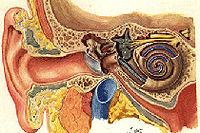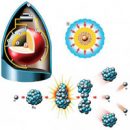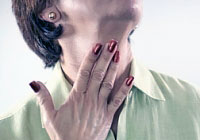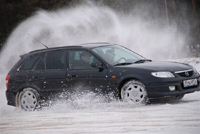Noise, Pressure, Chemicals. Learn how their impact is affected at the work of the ear
Content
Ear structure
The ear consists of three departments: outdoor, medium and internal.
 The outdoor ear includes an ear shell, which collects and directs sound waves, and the outer hearing passage, along which they pass to the eardrum, leading it in motion.
The outdoor ear includes an ear shell, which collects and directs sound waves, and the outer hearing passage, along which they pass to the eardrum, leading it in motion.
The middle ear consists of a drumpoint and three small bones (hammer, anvil and stirrups). Connected all together, they with a drum blade form a movable mechanical system of sound oscillations. Air pressure in the cavity of the middle ear corresponds to atmospheric due to the auditory, or Eustachiyeva, a pipe that connects it with the cavity of the nasopharynx. In children, this pipe is shorter and more direct than in adults, which makes it easier to penetrate infection from nasopharynx in the middle ear cavity.
The concept of the inner ear (labyrinth) includes three structures: snail, retail and semicircular channels. A snail has a direct attitude to the auditory analyzer (it contains a sound visible to the device), and intense and semicircular channels refer to the vestibular analyzer governing the balance, movement of the body in space, coordination of movements, etc.
The inner ear (snail) is filled with a liquid that turns oscillations transmitted from the middle ear to nerve impulses. That is, the oscillations of the membrane lead in the movement of the middle ear bone, the signal is enhanced and transmitted from the bones into the snail, where fluid oscillations excite the hair-receptors immersed in this liquid. These signals come in a hearing nerve in the brain.
Diseases of ear
Professional diseases of the ear develop for the following reasons:
- Long exposure to sharp noise, sounds and concussions
- sharp atmospheric pressure drops
- Toxic effects of certain chemicals used in the production process.
Long exposure to noise and sounds
The continuous impact of noise and sounds of excessive force causes an injury of the inner ear. An example of such an impact can be a sharp high sound whistle of the locomotive and the noise of the reactive engine, which gives 150-160 dB, which exceeds the threshold of pain sensitivity. Injury causes hemorrhage into a snail, offset and swelling of the cells of the spiral organ (located in the inner ear, directly draws the sound oscillation).
In modern industries, chronic acoustic (auditory) injuries are more common - at the factories of heavy industry, mechanical engineering, in weaving factories. The prolonged effect of noise with intensity from 70 to 100 dB and concussion causes a hearing analyzer lesion. The degree of hearing loss depends on the nature of noise and the duration of work in harmful production. The noise transmitted by the air, first cause hearing loss to high frequencies, and then to low.
Production processes accompanied by vibration reduce the perception of low-frequency sounds. The prolonged effect of vibrations spreading through bone conductivity causes destructive changes in the nerve cells of the ear and the vestibular apparatus. The impact of noise on the central nervous system is manifested in the form of increased fatigue, reduction of working capacity, the development of neurosis.
Sharp atmospheric pressure drops
 A sharp drops of atmospheric pressure cause damage to the ear called baryravm. This is a professional disease in divers and pilots, when working in caissons. With the normal patency of the auditory pipe (connects the ear and the nasopharynx, it also serves to equalize the pressure in both cavities) usually the alignment of the changing atmospheric pressure takes place. Violation of the patency of the hearing pipe with pressure drops leads to a sharp protrusion or indentation of the drumpoint up to its rupture. A rapid decline in pressure in the middle ear leads to the expansion of blood vessels, the transfer of transudate, the development of hemorrhages. Fast increase in atmospheric pressure can lead to severe pain.
A sharp drops of atmospheric pressure cause damage to the ear called baryravm. This is a professional disease in divers and pilots, when working in caissons. With the normal patency of the auditory pipe (connects the ear and the nasopharynx, it also serves to equalize the pressure in both cavities) usually the alignment of the changing atmospheric pressure takes place. Violation of the patency of the hearing pipe with pressure drops leads to a sharp protrusion or indentation of the drumpoint up to its rupture. A rapid decline in pressure in the middle ear leads to the expansion of blood vessels, the transfer of transudate, the development of hemorrhages. Fast increase in atmospheric pressure can lead to severe pain.
When barotrack, a otoscopic pattern may be different:
- hemorrhage in the drum cavity in the absence of a breakpoint break looks like dark blue shocking;
- The perforation of significant sizes and the yellow color of the emancipation mucous membrane is noted during the breakpoint breakpoint;
- Full destruction of the eardrum with intense injuries.
Hearing reduction occurs by the type of sound safety. With severe injuries, the pressure is transmitted to the inner ear, and the hearing defeat has a mixed character.
Barotravoma assistance is to prevent infection in the middle ear. To do this, Introduction in the outer hearing pass of a sterile cotton ball and the provision of a specialist consultation. In the case of secondary infection, purulent medium otitis is treated. Small breakpoint breakposses are frozen quickly, hemorrhage into the drum cavity is resolved more than a long time.
Toxic effects of chemicals
Toxic effects of chemicals causes the defeat of the inner ear. The lead and its compounds, mercury, arsenic and benzene possess toxic effect. There are cases of hearing damage when working with carbon monoxide. All these substances can cause hearing loss and deafness.









